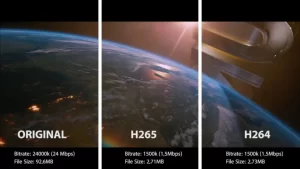Enhance your video and reduce the size
Video is an essential part of communication today, whether in advertising, education or entertainment. Therefore, it is important to choose the right format to achieve good quality and an acceptable size. In this article, we will compare two popular formats, H.264 and H.265, to help you choose the one that best suits your needs.
H.264
H.264 is a compressed video format that has been widely used in the video industry since 2003. This format is used for a wide range of applications, from live streaming to video distribution over the Internet. H.264 is supported by most video editing devices and programs, making it easy to use and accessible to a wide range of users.
Advantages:
- Compatibility: H.264 is compatible with a wide range of devices and video editing programs.
- Video quality: H.264 offers good video quality, especially for videos with smooth movements and intricate details.
Disadvantages:
- Large file size: Despite its good video quality, H.264 often results in a very large file size, which can be a problem for video streaming and storage.

H.265
H.265 is a compressed video format that was released in 2013 and is a significant improvement over H.264. This format is primarily used for high-definition video streaming applications. H.265 is a more efficient format in terms of file size, which means similar video quality can be achieved with a much smaller file size.
Advantages:
- Efficiency in terms of file size: H.265 is much more efficient in terms of file size than H.264, which means similar video quality can be achieved with a much smaller file size.
- Compatibility: H.265 is compatible with a wide range of devices and video editing programs.
Disadvantages:
- Compatibility: Although H.265 is supported by most devices and video editing programs, there are still some that are not.
- Longer encoding time: H.265 encoding is more complex and requires more time than H.264. This means that encoding a video can take longer and require more hardware resources.
In summary, H.264 and H.265 are both popular standards for video encoding, and each has its strengths and weaknesses. H.264 is more compatible and can be played on a wide variety of devices, but H.265 offers better video quality with a smaller file size.
If you’re looking to reduce the size of your videos without sacrificing quality, then H.265 is the way to go. However, if you need more compatibility, you may want to choose H.264. Ultimately, the choice depends on your specific needs and the available hardware and software resources.
